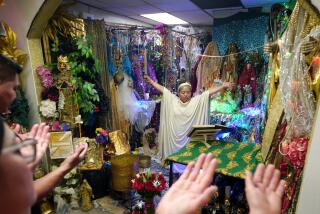Food, family and faith in Galicia, Spain
PONTEVEDRA, Spain â Galicia, the Atlantic-splashed left shoulder of Spain, grabbed my attention with photos of spectacular scenery and tempting cuisine. But truth be told, I wanted to see something more: the regionâs Sotomayor Castle, a medieval fortress that bears my surname.
I wanted to brag a bit about having spent a night at âmy castle.â
Like many Americans, Iâm delving into my familyâs genealogy, and although our roots are proudly anchored in Mexico, I found it fun to explore the origins of the Sotomayor name in Galicia on a six-day visit.
Castle or no, a visit to Galicia can be a delight for anyone. Itâs a region of splendid vistas, intriguing history and delicious seafood that comes from the Atlantic and from the rÃas â the estuaries that slice into Galiciaâs western coast like craggy fingers.
Iâm by no means a foodie â roasted chicken five days a week works for me â but I vowed that Galician gastronomy would be my destiny on this trip. And what a savory destiny it turned out to be, even boiled octopus, a Galician favorite known as pulpo.
I visited in mid-summer, avoiding the rainy seasons. From Madrid, I flew to Vigo on Galiciaâs southwestern coast. I rented a car and headed to the town and castle of Sotomayor, about 20 miles northeast.
The people of Galicia, known as Gallegos, speak Spanish and the regional language of Gallego. Thus, on maps and websites, the Spanish name Sotomayor often appears as Soutomaior.
At the castle, I met my cousin, Ernest Sotomayor, a dean at Columbia Universityâs Graduate School of Journalism, and his wife, Alicia. We strolled through the granite fortress, learning about its history. The castleâs original sections were built on a verdant hilltop as early as the 12th century, but main construction occurred in the 14th and 15th centuries. The castleâs best-known occupant was Pedro Alvarez de Sotomayor, a feudal lord who ruled the surrounding region, with both charisma and an iron hand, in the mid-15th century.
Legend has it that he and another nobleman agreed to divide contested land by riding on horseback toward each otherâs castle at the roosterâs first crow. The point where they met would be the boundary of their lands. Sotomayor took off at a gallop before dawn, gaining the major part of the disputed territory. He is celebrated in Galician history as Pedro Madruga (Pedro the Early Riser), and his life is still studied by historians.
In later centuries, the castle fell into disrepair. Restoration began in 1870. The castle and its Hotel Pousada del Castillo Soutomaior are now operated by the Pontevedra province council as tourist attractions and serve as a destination for weddings and cultural events.
After snapping hundreds of photos, Ernie, Alicia and I retreated to the hotel dining room. Our lunch of salad, fresh tuna empanadas and pulpo was scrumptious, accompanied by a bottle of Albariño, a fruity white wine produced from the castleâs vineyards. Then came dessert â cheesecake with a light chocolate crust and an orange whipped cream, sprinkled with fine cocoa and garnished with chocolate truffles and a cherry. It was outrageously rich and decadent to the last crumb.
After I checked into the hotel, about 100 yards from the castle, I sent friends and family my long-anticipated email, along with a photo of Ernie and me near the castleâs gate. âWe came, we saw, we reconquered,â I proclaimed, tongue in cheek, adding that for the time being we would let the status quo prevail at the castle and hotel.
After 48 hours at the castle and my goals accomplished, I bid adiós and headed for nearby Pontevedra, which was once the capital of Galicia. It didnât take long for the medieval-era city to win my heart. I stayed at the Parador de Pontevedra, one of a chain of 80-some hotels run by the Spanish government. The only disappointment was weak wireless service.
Stretching my legs, I got a great feel for the cityâs pedestrian-friendly historic district. Narrow cobblestoned streets wound their way between centuries-old granite walls, housing both residences and modern shops. I joined young people and families scouting for dinner tables on its numerous plazas. On a pleasant June night, the sun did not set until long after 10, and I sat for hours, sipping beer and enjoying a meal of fried calamari, potatoes and pulpo, sprinkled with olive oil and paprika.
Pontevedra is a city of 80,000, but I concentrated on its compact historic district. I visited the convent where Sister Lúcia Santos studied to be a nun. As a child, she was one of three young shepherds who reported an apparition of the Virgin Mary in 1917 in Fatima, Portugal. Years later, Lúcia reported that Mary had appeared to her in 1925 in her Pontevedra convent room, now a small shrine.
At one of Pontevedraâs five museums, the highlight was seeing a small model of Christopher Columbusâ Santa Maria flagship. Many in Pontevedra say the ship was built in the city and originally was called La Gallega. Such a distinction, however, is difficult to verify.
A museum supervisor, upon hearing my surname, told me that some âSotomayor noblemenâ were entombed in the cityâs large San Francisco Church. According to Pontevedra officials, the Sotomayor and other families, patrons of the church, made arrangements for those tombs.
Soon after entering the church, I spotted four burial vaults near the main altar. Atop each tomb was a granite statue of a man or woman. The man buried on the altarâs right side, I learned, was Payo Gómez Chariño de Sotomayor. Some histories report that he led forces that aided in the capture of Seville from the Moors in 1248.
As I exited the church, I received another surprise. Statues of a Spanish nobleman and his wife were mounted on the wall. The words, âHere lies Don Antonio Gago de Mendoza Soto Maior and Montenegro,â were etched next to the man and the date appears to be in the 1680s. I stared at the Soto Maior name, fantasizing that I â the son of a Mexican American gardener from Tucson â might have some distant connection to the men and women entombed in the church.
Later, I drove north about 35 miles to Santiago de Compostela and checked in at its five-star parador, Hostal de los Reis Católicos. It was originally a hospital commissioned by Queen Isabella and King Ferdinand in 1499. It cared for weary and ill pilgrims who had completed the Way of St. James â the pilgrimage to the city on foot from as far away as France or Portugal.
The pilgrimageâs destination is the Cathedral of St. James, a massive Romanesque structure that dates from the 12th century. An ancient story, backed by the Catholic Church, maintains that the remains of St. James are entombed there.
In the evening, I saw pilgrims, lugging heavy backpacks, enter the plaza and celebrate their arrival. Adding to the merry atmosphere, a gaitero, or bagpiper, struck up a Celtic tune, a musical remnant of a Celtic invasion that is said to have occurred from around 900 to 600 BC.
At Sunday Mass, the cathedral was bursting with people. Will, a young Nebraskan, told me that his pilgrimage walk had revived his spirituality and that he had gone to confession for the first time in years. The Mass afforded me the opportunity to pray and meditate in one of Catholicismâs most revered churches.
I later took a quick tour of the city aboard a tram, a ride that brought to a close my Galician adventure. Spain has many outstanding attractions, but Galicia is my favorite. Even if it were not home to the Sotomayor castle, Iâd go back at the first opportunity.
More to Read
Sign up for The Wild
Weâll help you find the best places to hike, bike and run, as well as the perfect silent spots for meditation and yoga.
You may occasionally receive promotional content from the Los Angeles Times.






